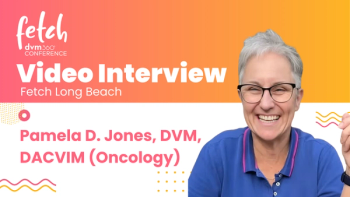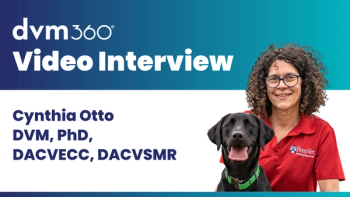
Vicky Ograin, MBA, RVT, VTS (Nutrition) explains the power of empathy in addressing owner concerns.

Vicky Ograin, MBA, RVT, VTS (Nutrition) explains the power of empathy in addressing owner concerns.

Learn from Adam Christman, DVM, MBA, and Peter Weinstein, DVM, MBA, as they chat about how purpose-driven leadership, mental health support, clear processes, and more.

Heidi Lobprise, DVM, DAVDC, discusses equipment needed for dental extractions, and why these tools are essential.

Christopher Lee, DVM, MPH, DACVPM, DACVM (Parasitology), explains that indoor pets still face vector exposure and that year-round isoxazoline protection reduces parasite burden and helps protect household members.

Smaller dogs have an increased incidence of periodontal disease, explains Heidi Lobprise, DVM, DAVDC, a veterinary dental specialist.

Laila Proença, DVM, PhD, MV, MSc, DACZM explains that affordable intraoral cameras plus mandatory pre- and post-extraction imaging let general practitioners perform safe, complete dental extractions.

Why do cat wag their tails? Annie Valuska, PhD, explains this behavioral cue and more in a dvm360 interview.

Pamela D. Jones, DVM, DACVIM (Oncology), recommends using CancerDx as a targeted screening tool for older and at risk dogs to detect lymphoma while limiting false positives.

What does it mean when a cat hisses? Annie Valuska, PhD, explaine in a dvm360 interview.

Laila Proença, DVM, PhD, MV, MSc, DACZM explains that affordable intraoral cameras plus mandatory pre- and post-extraction imaging let general practitioners perform safe, complete dental extractions.

Dr Sykes outlines why new evidence on leptospirosis epidemiology and safer vaccines led to a recommendation for annual vaccination of all dogs.

Vicky Ograin, MBA, RVT, VTS (Nutrition) recommends assessing and optimizing a patient’s nutritional plane before elective surgery and sending patients home on a complete, digestible GI diet to improve outcomes.

Christopher Lee, DVM, MPH, DACVPM, DACVM (Parasitology), argues for year-round isoxazoline use, noting that interrupting the flea life cycle protects both pets and people.

Annie Valuska, PhD, principal scientist for the pet behavior team at Purina, discusses common ways for dogs to convey a calming signal.

Pamela Jones, DVM, DACVIM (Oncology), explains why lymphoma isn’t one disease and how phenotyping, client goals, and teamwork guide individualized treatment.

Annie Valuska, PhD, principal scientist for the pet behavior team at Purina, discusses one of the most common ways for dogs to convey emotions.

Benita Altier, LVT, VTS (Dentistry), discusses the types of dentistry cases that a general practitioner might be more comfortable referring to a specialist.

Peter Weinstein, DVM, MBA, urges veterinary teams to adopt WONJI (Working On, Not Just In) by scheduling regular time away from day-to-day duties to build vision, values, and strategy.

Heidi Lobprise, DVM, DAVDC, discusses the importance of dental care for senior pets, addressing periodontal disease, stomatitis, and tooth resorption.

Susan Little, DVM, PhD, DACVM (Parasitology), explains how transmission timing differs by pathogen, demonstrates safe tick removal, and shows why year-round systemic tick control plus targeted vaccines best protect pets.

Alex Sigmund, DVM, DACVO, explains how to evaluate senior patients’ eyes, weigh medication and surgical risks, and use simple exams to guide compassionate and practical care.

Benita Altier, LVT, VTS (Dentistry), discusses the importance of good posture when caring for patients and how dentistry tools can help.

Discover key insights on decision-making biases in veterinary care from Erik Zager, DVM, DACVECC.

Monica Tarantino, DVM, MBA, highlights the importance of proactive chronic pain management in elderly dogs.

Heidi Lobprise, DVM, DAVDC, shares practical tips and easy-to-use tools to protect soft tissues and improve safety during extractions, in this interview with dvm360.

Cynthia M. Otto, DVM, PhD, DACVECC, DACVSMR, explains what competing techniques the research team looked at and how they can further this research.

Veterinary dental expert Heidi Lobprise, DVM, DAVDC, shares her technique for extracting an upper fourth premolar, in this interview with dvm360.

Otto breaks down the physiology and field data behind the head dunk technique and why active cooling is preferable to passive rest in hot conditions.

Learn 3 essential vaccine management tips from Christopher Lee, DVM, MPH, DACVPM, DACVM (Parasitology), focusing on epinephrine use, hypersensitivity reactions, and optimal vaccine locations.

Jack Teitelman, CEO and founder of TITAN Group, shares key takeaways from his New York Vet Show session on DEA compliance.